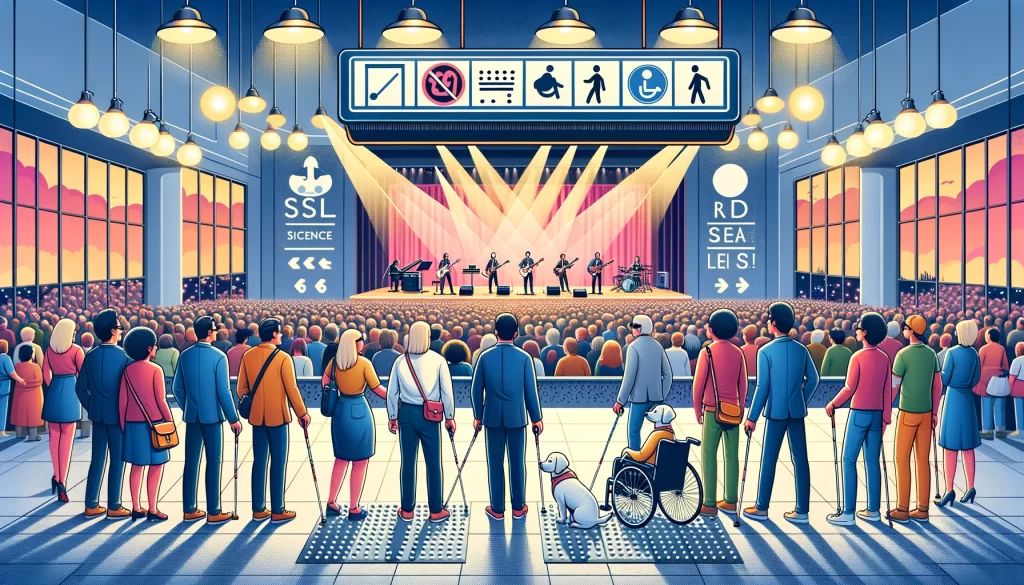Illustration depicting a venue accessible for blind and visually impaired guests.
10 Great Tips on Making Concert Venues Accessible for Blind and Visually Impaired Guests
It’s a common question we get asked a lot: “Do blind people really go to concerts?” And the answer is a resounding YES, of course they do! People who are blind or visually impaired enjoy concerts just as much as anyone else. Music is a universal experience that transcends visual limitations, offering an immersive world of sound, rhythm, and emotion. This is why it’s extremely important to make concerts and concert venues more inclusive and accessible for blind and visually impaired guests.
Attending concerts allows individuals with visual impairments to connect with the music, feel the energy of the crowd, and enjoy a shared experience with others. It’s a reminder that enjoyment of the arts is a right accessible to all, regardless of physical abilities.
The ADA sets minimum requirements for concerts and ticketing but doesn’t focus on venues being accessible for blind guests. Creating a concert space that’s accessible for blind and visually impaired guests is about more than just including everyone; it also makes the event more enjoyable for everyone. Here are “10 Tips on Making Concert Venues Accessible for Blind and Visually Impaired Guests”:
Tactile Pathways
The first step towards accessibility is installing tactile pathways. These textured ground indicators help visually impaired guests navigate through the venue independently, leading them from entrances to their seats, restrooms, and essential facilities.Audio Descriptions
Audio descriptions provide a live commentary of the event’s visual elements, including the performers’ actions, expressions, and stage settings. Offering this service through headsets can significantly enrich the concert experience for blind attendees.Braille and Large Print Materials
Ensuring that all printed materials, such as programs, menus, and directional signs, are available in both Braille and large print, caters to a wider range of visual impairments. This small adjustment can make a big difference in making guests feel welcomed and informed.Reserved Seating Areas
Designating specific seating areas closer to the stage for visually impaired patrons can significantly enhance their auditory experience. This thoughtful arrangement allows them to enjoy the concert more fully, despite visual limitations.Staff Training
Educating staff members on how to effectively assist blind and visually impaired individuals is crucial. This training should cover offering arm assistance, providing clear and concise verbal directions, and understanding the basic etiquette of interacting with visually impaired individuals.Website Accessibility
In today’s digital age, it’s important that the venue’s website is accessible to all. This includes compatibility with screen readers and the option to book accessible seating online. An accessible website is often the first step in creating an inclusive experience.Accessible Transportation Options
Collaborating with transportation services that cater to the needs of the visually impaired ensures that guests have a smooth experience getting to and from the venue. Providing information about these services on the venue’s website and in event communications is also beneficial.Braille Signage
Implementing Braille signage throughout the venue, especially at key locations like restrooms, exits, and customer service desks, aids in independent navigation and enhances safety for visually impaired guests.Emergency Procedures
Ensuring that emergency procedures are accessible is vital. This includes having clear, audible emergency announcements and instructions tailored for guests with visual impairments. Regular drills and staff training in these procedures are equally important.Feedback System
Establishing a feedback system specifically for visually impaired patrons allows the venue to receive direct input on their experience. This feedback is invaluable in making continuous improvements and in understanding the unique needs and preferences of visually impaired guests.
By implementing these measures, concert venues can significantly improve the accessibility and enjoyment of their events for blind and visually impaired attendees. Such inclusive practices not only cater to a wider audience but also demonstrate a commitment to diversity and equality in the entertainment industry.
Additionally, having your facility evaluated for inclusivity and accessibility is crucial. It’s not just about meeting legal requirements; it’s about truly welcoming everyone. An evaluation can reveal unseen barriers and provide solutions, ensuring that all guests have a memorable and comfortable experience. This commitment to accessibility reflects a respect for diversity and promotes a positive image of your venue in the community.
To learn more about how Equal Accessibility® can help you make your concert venue more inclusive and accessible contact us today!

